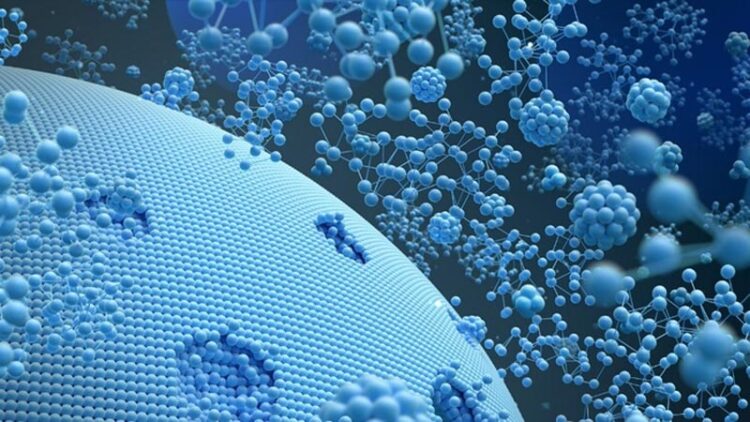Observation of quasi-equilibrium phase coexistence in supercritical fluids

Particle transport on the droplet surface suspended in a supercritical fluid is not achieved by individual atomic units, but by clusters of nanometer-sized particles.
Credit: POSTECH
A long-lasting non-equilibrium phase coexistence in supercritical fluids has been observed by a Korean research team.
A team of researchers led by Professor Gunsu S. Yun from POSTECH’s Department of Physics and the Division of Advanced Nuclear Engineering and Professor Dong Eon Kim of the Department of Physics and Max Planck POSTECH/Korea Research Initiative (MPK) has observed the non-equilibrium phase coexistence in supercritical fluids lasting several hours. The researchers explained the phenomenon through a mass transport model at the phase coexistence interface, where the transport occurs in chunk of nano-sized clusters instead of single atoms.
It has been accepted as scientific knowledge for about 200 years that when the temperature and pressure of a fluid rise above a certain level called the critical point, the boundary between liquid and gas disappears and a change of state no longer occurs. However, in the 2010s, research findings reported that supercritical fluids may have liquid or gas properties depending on temperature and pressure conditions. Since then, it has been continuously confirmed through various experiments and simulations that multiple states exist in the supercritical fluid region. However, the possibility of a state in which a plurality of phases coexists rather than a single phase at the same temperature and pressure point – that is, a state similar to that in which a general liquid and gas coexist after phase separation – has not been discussed.
To this, the joint research team, in the process of making a supercritical argon fluid using a high-pressure chamber that operates in successive compression-expansion cycles, demonstrated a state where a large amount of argon droplets (formed by adiabatic expansion cooling) coexist with the gas-like supercritical background while maintaining their liquid-like properties. The state where these two phases coexist in isolation persists a surprisingly long time and the researchers presented a new mass transport model mediated by nano-clusters – an improvement on the conventional evaporation model – to explain the phenomenon.
Supercritical fluids are being used in various industries such as heat exchange systems in power plants, pharmaceutical processes, semiconductor cleaning, and food processing thanks to their beneficial properties such as low viscosity and high solubility. The non-equilibrium phase coexistence in supercritical fluids discovered in this study has a significant impact on the physical and chemical properties such as heat capacity, thermal conductivity, and viscosity, which may prove important for supercritical fluid processing in industrial applications.
In addition, this achievement is of significant academic value in that it laid the foundation for related research by identifying for the first time the nonequilibrium phase coexistence of supercritical fluids, which is an unexplored area.
“Research on nonequilibrium of supercritical fluids is not only helpful in industrial processes, but also helpful in understanding various supercritical fluids that exist in the natural world, as in the atmospheres of planets such as Venus and Jupiter, volcanic eruptions, and fluids in the Earth’s crust,” remarked Professor Gunsu S. Yun who participated as a co-corresponding author in the study. “Our findings will contribute to understanding the transport properties of supercritical fluids.” He added, “We are conducting research to theoretically interpret nonequilibrium phase coexistence in supercritical fluids beyond experimental results.”
The findings from this study were published on July 30, 2021 in Nature Communications. The research was conducted with the support from the National Research Foundation of Korea and the Max Planck Korea/POSTECH Research Initiative.
Journal: Nature Communications
DOI: 10.1038/s41467-021-24895-y
Article Title: Observation of Quasi-equilibrium Phase Coexistence in Supercritical Fluids
Article Publication Date: 30-Jul-2021
Media Contact
Jinyoung Huh
Pohang University of Science & Technology (POSTECH)
jyhuh@postech.ac.kr
Office: 82-54-279-2415
All latest news from the category: Physics and Astronomy
This area deals with the fundamental laws and building blocks of nature and how they interact, the properties and the behavior of matter, and research into space and time and their structures.
innovations-report provides in-depth reports and articles on subjects such as astrophysics, laser technologies, nuclear, quantum, particle and solid-state physics, nanotechnologies, planetary research and findings (Mars, Venus) and developments related to the Hubble Telescope.
Newest articles

First-of-its-kind study uses remote sensing to monitor plastic debris in rivers and lakes
Remote sensing creates a cost-effective solution to monitoring plastic pollution. A first-of-its-kind study from researchers at the University of Minnesota Twin Cities shows how remote sensing can help monitor and…

Laser-based artificial neuron mimics nerve cell functions at lightning speed
With a processing speed a billion times faster than nature, chip-based laser neuron could help advance AI tasks such as pattern recognition and sequence prediction. Researchers have developed a laser-based…

Optimising the processing of plastic waste
Just one look in the yellow bin reveals a colourful jumble of different types of plastic. However, the purer and more uniform plastic waste is, the easier it is to…


